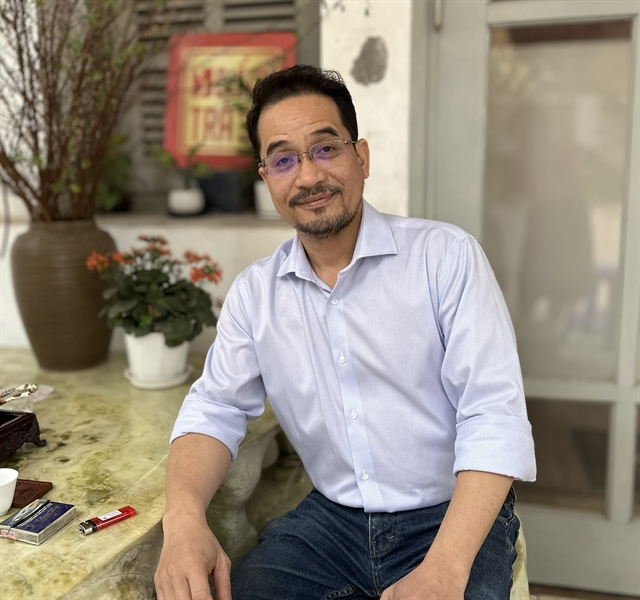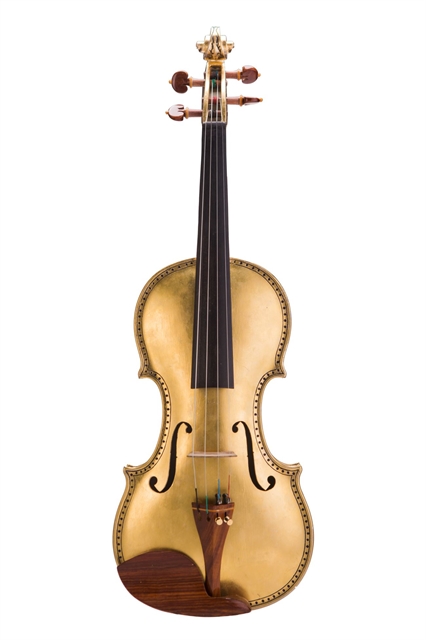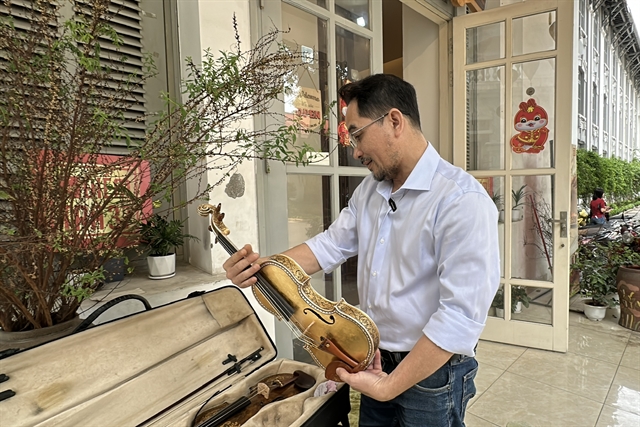 Inner Sanctum
Inner Sanctum

Violinist-craftsman Nguyễn Xuân Huy has long been respected as one of Việt Nam’s talented string musicians. But his name is now making waves for a completely different reason: he may be the first person in the world to create fully playable violins from porcelain. Huy shares with Việt Nam News reporter Lê Hương about his creative journey.
Inner Sanctum: Why did you want to make a violin from porcelain?
I’ve been making wooden violins for years, and I’ve always loved the process - it’s delicate, complex, and deeply rewarding. But once I had made enough and understood the craft thoroughly, I began asking myself: “Can I do more? Can I create something different - something that lasts longer, carries an artistic soul, and pushes boundaries?”
I'm also an artist by nature. I love to paint and sculpt. So I thought: why not combine music and visual art? That’s how the idea of using porcelain came about. It’s a challenging material, yes, but it also offers a sense of permanence and artistic freedom. I could engrave, paint, or decorate it however I liked. And so, I began this journey with no knowledge of ceramics - just an idea.
 |
| Violinist Nguyễn Xuân Huy. VNS Photo Lê Hương |
Inner Sanctum: How did you begin turning that idea into reality?
At first, I was starting from zero - how to work with clay, fire it, or glaze it. All I had was my background in violin-making and a strong desire to learn. I started visiting ceramics workshops, talking to experienced artisans, and trying to learn as much as I could.
But porcelain is extremely difficult to work with. A violin has complex curves and must be thin enough to produce sound, yet strong enough not to break. During firing, the material can warp, crack, or shrink. Ceramics experts call this “fire transformation” - you never really know how the shape will change inside the kiln.
I spent years experimenting, refining molds, and testing different clay formulas. The learning curve was steep. There were many failures. I began working on this in 2014, and it wasn’t until 2017 that I created my first fully functional porcelain violin.
Inner Sanctum: What is the process of making a porcelain violin like?
It's a very long and delicate process. First, I make a wooden prototype, then I make a plaster mold from it. After that, I pour in liquid kaolin clay. Once it sets, I carefully remove the mold, dry it, and do a preliminary firing. Then comes the hand-carving, fine tuning, glazing, and the final firing.
But it doesn’t end there. After completing the ceramic body, I still have to assemble the components - the fingerboard, pegs, bridge, and strings. All of these must be adjusted precisely so that the violin can produce music. Unlike wooden violins, which can be reshaped or repaired during the working process, porcelain is unforgiving. One crack or defect means starting from scratch.
 |
| A porcelain violin made by Huy, with which he played for the royal Japanese court at a party to celebrate the 45th diplomatic tie between Việt Nam and Japan held in Tokyo on June 1, 2018. |
Each porcelain violin takes months to complete. And even then, there's no guarantee it won’t break during firing. That’s why, after more than a decade, I’ve only successfully made six pieces.
Inner Sanctum: How does a porcelain violin sound compared to a wooden one?
Porcelain has a very distinct sound. It’s bright, clear, and somewhat crystalline - different from the warm, deep resonance of wood. Some people, especially those familiar with ceramics, tap the violin and say it sounds like stone or even immature ceramic. But that’s because inside the violin are all the usual acoustic structures: sound posts, bass bars, and other parts that are designed to absorb and control sound.
In fact, if a violin rings too much when you tap it, that’s usually a bad sign - it means it won’t resonate properly when played. A well-made violin tends to absorb sound when tapped and releases it when bowed. That’s the principle I follow with the porcelain ones as well.
So while the sound is different, it’s still rich and unique. It’s not better or worse - it’s just another voice, another texture. And that, to me, is exciting.
Inner Sanctum: Do you think porcelain violins can be used in daily musical practice or performances?
Porcelain violins aren’t meant for everyday practice or concerts. They’re not as practical as wooden violins when it comes to performance. Their strength lies in their artistic and collectible value. They are pieces of art - sculptures that also happen to produce sound.
What makes them special is that they’re playable artworks. You can decorate them with paintings and engravings. That’s something you can’t really do with a wooden violin without affecting the sound quality.
 |
| Artist Huy introduces one of his porcelain violins. VNS Photo Lê Hương |
Inner Sanctum: What has the reaction been like to your work so far?
The reaction has been really encouraging. In October 2024, I donated a porcelain violin to the Heritage Museum in Huế. It was part of a special set - a trio of art pieces, including two violins and one decorative sculpture. Before that, I gave a violin to the former Emperor of Japan. It’s now displayed in the imperial palace.
These moments mean a lot to me. They tell me that what I’m doing has cultural and artistic value beyond just music. In the future, I hope to see my violins displayed in major museums - perhaps in France, Russia, or other countries that deeply appreciate both classical music and fine arts.
I’m also working on registering a world record, since as far as I know, no one else has made a playable porcelain violin before. It would be an honour to have that recognition for Việt Nam. VNS
 |
| Huy (left) receives the Việt Nam record certificate for the first porcelain violin maker and player in Việt Nam by the Việt Nam Record Association. Photo courtesy of Võ Văn Tường |




